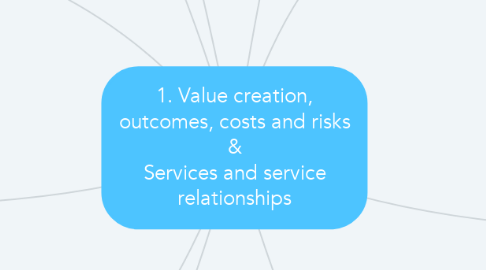
1. Value Creation
1.1. Value is the perceived benefits, usefulness and importance of something, can be subjective
1.1.1. Balance between
1.1.1.1. Affected outcomes, costs introduced, risk introduced
1.1.1.2. Reported outcomes, costs removed, risks removed
1.2. Value creation is a balancing act involving outcomes, costs and risks.
2. Key StakeHolders
2.1. Organisation
2.1.1. A person or a group of people that has its own function with responsibilities, authorities, and relationships to achieve its objectives.
2.2. Customer
2.2.1. A person who defines the requirements for a service and takes responsibility for the outcomes of service consumption.
2.3. User
2.3.1. A person who uses services
2.4. Sponsor
2.4.1. A person who authorizes budget for service consumption
2.5. It is important that relationships with all key stakeholders are understood and managed.
3. Value co-creation is Essential
3.1. Bad Example
3.1.1. “Service provider” acting in isolation The provider delivers the service and the consumer receives value, but the consumer plays no role in the creation of value for themselves.
3.2. Good Example
3.2.1. Active collaboration between provider & consumer Increasingly more consideration is put into the highly complex and interdependent service relationships that exist in reality. Both parties actively seek to establish mutually beneficial, interactive relationships with them consumers, empowering them to be creative collaborators in the service value chain.
4. Output and Outcome
4.1. Output
4.1.1. A tangible or intangible deliverable of an activity.
4.2. Outcome
4.2.1. A result for a stakeholder enabled by one or more outputs.
4.3. Service providers should help their consumers to achieve outcomes. It can be difficult for the provider to fully understand the outcomes that the consumer wants to achieve.
5. Costs and Risks
5.1. Costs
5.1.1. Removed
5.1.1.1. from the consumer by the service (a part of the value proposition)
5.1.2. Introduced or Imposed
5.1.2.1. on the consumer by the service (the costs of service consumption). Some consumers describe this as what they have to ‘invest’ to consume the service
5.1.3. The amount of money spent on a specific activity or resource
5.2. Risk
5.2.1. A possible event that could cause harm or loss or make it more difficult to achieve objectives. Can also be defined as “uncertainty of outcome”.
5.2.2. Removed
5.2.2.1. from the consumer by the service (a part of the value proposition)
5.2.3. Introduced
5.2.3.1. on the consumer by the service (risks of service consumption)
6. Utility and Warranty
6.1. Utility The functionality offered by a product or service to meet a particular need.
6.2. Warranty Assurance that a product or service will meet agreed requirements.
7. Service Providers and Consumers
7.1. Provider
7.1.1. External or internal, could be selling services on the open market to other businesses, or to individual consumers
7.2. Consumer
7.2.1. Is a Generic role, used to simplify, in practice, more roles involved such as costumers, user and sponsors
8. Services and Products
8.1. Service offering
8.1.1. One or more services, designed to address the needs of a target consumer group. A service offering may include goods, access to resources, and service actions.
8.1.1.1. Goods
8.1.1.1.1. Supplied to the consumer Ownership is transferred to the consumer Consumer takes responsibility for future use
8.1.1.2. Access to resources
8.1.1.2.1. Ownership is not transferred to the consumer Access is granted or licensed to the consumer under agreed terms and conditions The consumer can only access the resources during the agreed consumption period and according to other agreed service terms
8.1.1.3. Service actions
8.1.1.3.1. Performed by the service provider to address a consumer’s needs Performed according to an agreement with the consumer
8.2. Service
8.2.1. A means of enabling value co-creation by facilitating outcomes that customers want to achieve, without the customer having to manage specific costs and risks
8.3. Products
8.3.1. A configuration of an organization’s resources designed to offer value for a consumer
9. Service Relationship
9.1. It is important that relationships with all key stakeholders are understood and managed.
9.2. The roles of service provider and service consumer are not mutually exclusive, and organizations typically both provide and consume a number of services at any given time.
10. Service Relationship Model
10.1. Service relationship
10.1.1. A cooperation between a service provider and service consumer. Service relationships include service provision, service consumption, and service relationship management.
10.2. Service Provision
10.2.1. Activities performed by an organization to provide services. Service provision includes: ●● management of the provider’s resources, configured to deliver the service ●● ensuring access to these resources for users ●● fulfilment of the agreed service actions ●● service level management and continual improvement. Service provision may also include the supplying of goods
10.3. Service consumption
10.3.1. Service consumption
10.4. Service relationship management
10.4.1. Joint activities performed by a service provider and a service consumer to ensure continual value co-creation based on agreed and available service offerings
